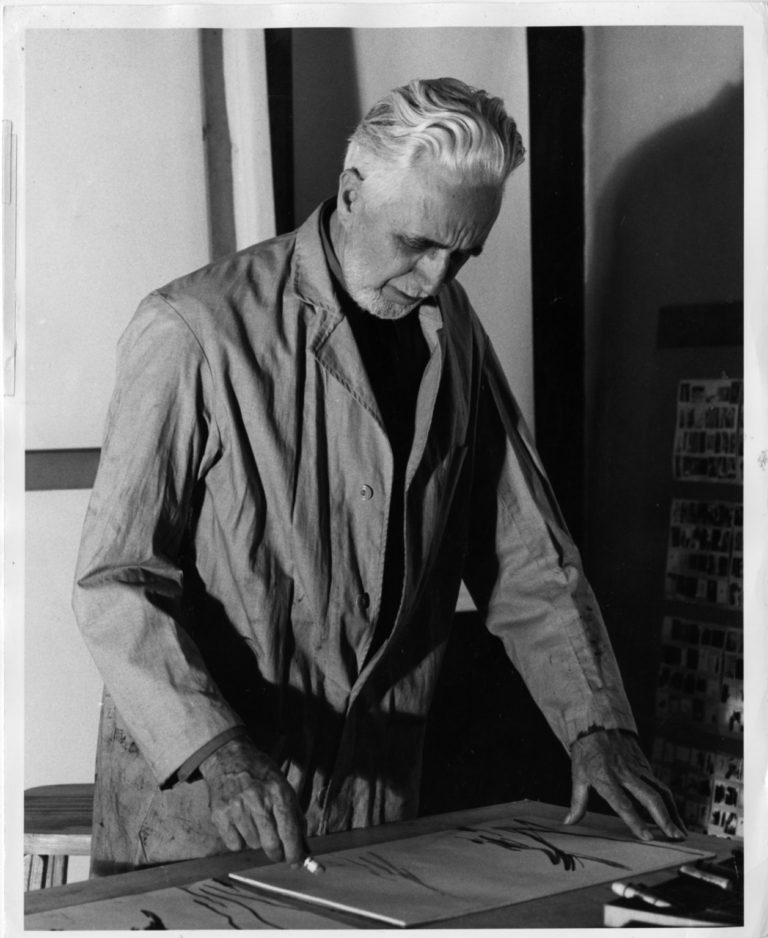By Kristin Kirsch Feldkamp
“Coming to the Clyfford Still Museum was a great fluke,” Michal Mikesell, Clyfford Still Museum (CSM) assistant conservator of paper said. “I was in my pre-program internship in 2010 at the Denver Art Museum (DAM) and working with James Squires, now CSM’s chief conservator of paintings, and Sarah Melching, paper conservator and director of conservation at the DAM. I was able to watch Squires address the paintings and I worked with Melching to address the works on paper for CSM’s inaugural exhibition.” Mikesell spent the subsequent years coming back to CSM on a temporary basis to house the paper collection until she joined the CSM team full time in 2017.
But treating works on paper for the inaugural show wasn’t her first encounter with Clyfford Still’s work. “When I lived in New York, I’d constantly go to The Met,” she said. “I’m into art, but I’m notorious for never reading a wall label. I spent six years, every weekend going into a gallery in The Met and staring at the minutiae of the paint interlayers in such Still works as “Untitled,” 1960 and “Untitled,” 1950. I never knew it was Still’s work I was looking at until I was working with Squires and I saw a painting and thought, that looks oddly familiar and then looked it up.”
Mikesell laughed as she would often during our 45-minute conversation about Clyfford Still and her favorite work of the moment, PP-970. Her passion for her job and a convivial personality made for a highly animated and enjoyable chat. EXCERPTS:

Feldkamp: The works on paper have been called a visual diary. What does that mean to you?
Mikesell: I think it’s been called a visual diary to provide the audience with an access point. Out of Still’s entire artistic output, the works of art on paper, the oil pastel and construction paper, are dated to the day. I can’t think of something outside that subset of the collection that is dated to the day except one painting that was intended as a present to Patricia [Still]. We essentially have a daily snapshot of what Still was working on through this body of work and I think that’s why they call it a visual diary. I think of it as his sketchbook. He never really kept a sketchbook.

Feldkamp: I’ve heard that Still felt his works on paper were personal.
Mikesell: I’ve worked specifically with paper now for a number of years. Sketchbooks are a very desirable thing because they are inherently so personal. I think because of the way Still worked — his paintings took so much physical energy, so much time — that maybe he felt the works on paper were so personal because he wasn’t as rigid in the output.
Feldkamp: Tell us about your favorite.
Mikesell: PP-970 is a recent favorite. It’s officially my ninth favorite, in no particular order. I make notes as I go through the collection about works that strike me on an emotional level because I’m so constantly and pervasively absorbed with the materials and the condition. PP-970 has such luminosity. It’s a later work, 1977.
Feldkamp: Very late. [Still died in 1980.]
Mikesell: Yes. And the pastel’s on a beautiful black paper. I think there are somewhere around eight different types of black paper and PP-970 uses one of the types of paper I like best. The paper fibers themselves are evenly distributed. It’s good quality and in good condition. You don’t have much loss of the colorant. It’s got a dark turquoise, a purple, a pink, and then a light blue [pastel]. But then up here [points to the paper], in this central highlight passage, there’s a very dark blue and actually a black. We tend to think of his works on paper as very quick and gestural. I don’t think they’re that gestural.
Feldkamp: Is there one thing you want others to know about Still’s works on paper? Something you think isn’t talked about enough?
Mikesell: It’s hard to talk about the papers. Still’s considered a painter. Even though he’s an excellent draftsman, he’s not known for his drawings per se. So, I think in many instances his papers get overlooked and that’s unfortunate. I think that some of his works on paper are equally if not more successful than his paintings simply because he figured out the smaller scale, and they’re wonderfully intimate.
Interested in learning more about Still’s works on paper? Visit our Works on Paper online publication and video about Works on Paper.
